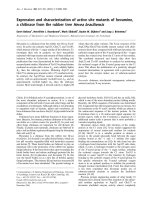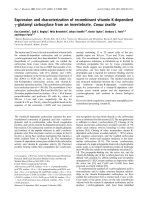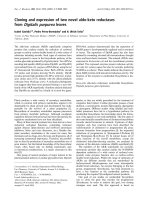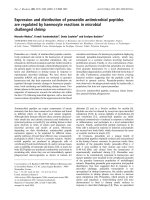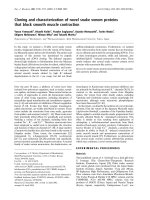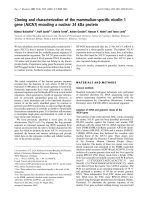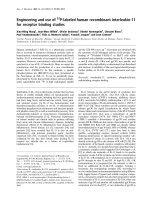Báo cáo y học: "Pattern and outcome of chest injuries at Bugando Medical Centre in Northwestern Tanzania" pptx
Bạn đang xem bản rút gọn của tài liệu. Xem và tải ngay bản đầy đủ của tài liệu tại đây (425.45 KB, 7 trang )
RESEARCH ARTICLE Open Access
Pattern and outcome of chest injuries at Bugando
Medical Centre in Northwestern Tanzania
Monafisha K Lema
†
, Phillipo L Chalya
*
, Joseph B Mabula
†
, William Mahalu
†
Abstract
Background: Chest injuries constitute a continuing challenge to the trauma or general surgeon practicing in
developing countries. This study was conducted to outline the etiological spectrum, injury patterns and short term
outcome of these injuries in our setting.
Patients and methods: This was a prospective study involving chest injury patients admitted to Bugando Medical
Centre over a six-mont h period from November 2009 to April 2010 inclusive.
Results: A total of 150 chest injury patients were studied. Males outnumbered females by a ratio of 3.8:1. Their
ages ranged from 1 to 80 years (mean = 32.17 years). The majority of patients (72.7%) sustained blunt injuries.
Road traffic crush was the most common cause of injuries affecting 50.7% of patients. Chest wall wounds,
hemothorax and rib fractures were the most common type of injuries accounting for 30.0%, 21.3% and 20.7%
respectively. Associated injuries were noted in 56.0% of patients and head/neck (33.3%) and musculoskeletal
regions (26.7%) were commonly affected. The majority of patients (55.3%) were treated successfully with non-
operative approach. Underwater seal drainage was performed in 39 patients (19.3%). One patient (0.7%) underwent
thoracotomy due to hemopericardium. Thirty nine patients (26.0%) had complications of which wound sepsis
(14.7%) and complications of long bone fractures (12.0%) were the most common complications. The mean LOS
was 13.17 days and mortality rate was 3.3%. Using multivariate logistic regression analysis, associated injuries, the
type of injury, trauma scores (ISS, RTS and PTS) were found to be significant predictors of the LOS (P < 0.001),
whereas mortality was significantly associated with pre-morbid illness, associated injuries, trauma scores (ISS, RTS
and PTS), the need for ICU admission and the presence of complications (P < 0.001).
Conclusion: Chest injuries resulting from RTCs remain a major public health problem in this part of Tanzania.
Urgent preventive measures targeting at reducing the occurrence of RTCs is necessary to reduce the incidence of
chest injuries in this region.
Background
Trauma continues to be an enormous public health pro-
blem worldwide and it is associated with high morbidit y
and mortality both in developed and developing coun-
tries[1].Traumaisreportedtobetheleadingcauseof
death, hospitalization, and long-term disabilities in the
first four decades of life.
Globally, 10% of all trauma admissions result from
chest injuries and 25% of trauma-related deaths are
attributable to chest injuries [2,3].
In Tanzania, trauma including chest injuries continues
to be one of the leading causes of morbidity among the
young and old with an estimated mortality of 40% [4].
In Bugando Medical Centre , chest trauma has been
commonest cause of surgical admission and contributes
significantly to high morbidly and mortality [5].
The causes and pattern of chest injuries have been
reported in literature to vary from one part of the world
to another partly because of variations in infra structure,
civil violence, wars and crime. Road traffic crushes
(RTCs) are the commonest cause of chest injuries in civi-
lian practice accounting for up to 70% in some series
[6,7]. With increasing use of firearms, arrows and spears
the incidence of penetrating chest injuries increased in
civil society [8]. They are often associated with other
* Correspondence:
† Contributed equally
Department of Surgery, Weill- Bugando University College of Health
Sciences, Mwanza, Tanzania
Lema et al. Journal of Cardiothoracic Surgery 2011, 6:7
/>© 2011 Lema et al; licensee BioMed Central L td. This is an Open Access article distributed under the t erms of the Creative Commons
Attribution License (http://cre ativecommons.org/licenses/by/2.0), which permits unrestricted use, distribution, and reproduction in
any medium, provided the original work is properly cited.
extra-thoracic injuries particularly to the abdomen and
long bones [8,9].
Studies have shown that most chest injuries can be
treated by non-surgical approach with relatively simple
methods, such as tube thoracostomy, appropriate analge-
sics management, and good pulmonary toilet [10,11].
The accurate identification of a patient at high risk for
major chest injuries is necessar y to avoid delays that may
lead to significant morbidity and mortality [12]. Aggres-
sive management of the chest trauma along with prompt
treatment of associated injuries is essential for optimal
patient outcome [13].The majority of chest injuries are
preventable. A clearer understanding of the causes, injury
patterns and outcome of these patients is essential for
establishment of prevention strategies as well as treat-
ment protocols [14]. Such data is lacking in our environ-
ment as there is no local study which has been done.
This study was conducted in our setting to describe
our own experien ce in the management of c hest inju-
ries, outlining the etiologica l spectrum, injury patterns
and outcome of chest injuries in our local setting. The
study results will provide basis for planning of preven-
tion strategies and establishment of treatment protocols.
Patients and Methods
Study design and Setting
This was a prospect ive study which was conducted at the
Accident and Emergency (A&E) department and surgical
wards of Bugando Medical Centre (BMC) over a six-
month period from November 2009 to April 2010 inclu-
sive. Bugando Medical Centre is a referral, consultancy
and teaching hospital for Weil Bugando University College
of Health Sciences (WBUCHS) and other paramedics and
it is located in Mwanza city in the northwestern part of
Tanzania. It is situated along the shore of Lake Victoria
and has a bed capacity of 1000. BMC is one of the four
largest referral hospitals in the country and serves as a
referral centre for tertiary specialis t care for a catchment
population of approximately 13 million people from
Mwanza, Mara, Kagera, Shinyanga, Tabora and Kigoma.
Trauma patients are first seen at the A & E depart-
ment where the surgical team does primary and second-
ary surveys. The surgical team comprising of intern
doctors, Registrar [Medical Officers], Resident [Post-
graduate student in Surgery] and Surgeon. From the
A & E department these patients are admitted in respec-
tive surgical wards after definitive treatment either in
operating theatre or at the A & E department.
Study subjects
The study population included all chest injury patients
of all age groups and both genders admitted to the sur-
gical wards of BMC during the study period. Uncon-
scious patients without next of kin to consent and give
information and t hose who were still in the ward at the
end of study period were excluded from the study.
Patients who died before complete assessment and those
who absconded against medical advice were also
excluded. Recruitment of patient to participate in the
study was done at the A&E department after primary
and secondary surveys done by t he admitting surgical
team. Patients were screened for inclusion criteria and
those who met the inclusion criteria were offered expla-
nations about the study and requested to consent befo re
being enrolled into the study. The diagnosis of chest
injury was made by clinical history, physical examination
and abnormal chest radiographs at the accident and
emergency department. Chest injuries were considered
as both blunt and penetrating affecting the chest wall
and the contents of the thorax e.g. pleura, lungs, lower
respiratory tract, esophagus, heart and great vessels. All
recruited patients were managed according to advanced
trauma life support [ATLS].
Associated injuries were managed appropriately
according to type of injury. The authors ensured that
the study patients were receiving the appropriate treat-
ment and supportive care as prescribed by the surgeon.
Patients were followed up till discharge or death. The
length of hospital stay and mortality as measures of out-
come of chest injury patients was recorded at the end of
follow up period. The minimum follow-up period was
thirty days. Data was collected using a pre-teste d coded
questionnaire. Data administered in the questionnaire
included; demographic characteristics (e.g. age, sex), cir-
cumstances of injury, characteristics of injury causes,
management, complications, Length of Hospital Stay
(LOS) and mortality.
Data collection and analysis
Data collected was entered into a computer and an a-
lyzed using SPSS software version 11.5 with help of a
medical statistician. Data was summarized in form of
proportions and frequency tables for categorical vari-
ables. Means, median, mode, standard deviation and his-
tograms were used t o summarize continuous variables.
Chi-square test was used to test for significance of asso-
ciations between the predictor and outcome variables in
the categorical variable s. Student t-tes t was used to test
for significance of associations between the predictor
and outcome variables in the continuous variables. Mul-
tivariate logistic regression analysis was used to deter-
mine predictor variables that are associated with
outcome. Significance was defined as a p-value of less
than 0.05.
Ethical consideration
Ethical approval to conduct the study was obtained from
the WBUCHS/BMC joint insti tutional ethi c review
Lema et al. Journal of Cardiothoracic Surgery 2011, 6:7
/>Page 2 of 7
committee before the commencement of the study.
Informed consent was sought from each patient before
recruitment into the study.
Results
A total number of 150 chest injury patients were stu-
died. Their ages ranged from 1 to 80 y ears with a mean
of 32.17 years and standard deviation of 14.74. The
median and the mode were 30.00 and 22.00 years
respectively. The peak age incidence was 21-30 years
There were 119 (79.3%) males and 31 (20.7%) females
with the male to female ratio of 3.8:1 with a male pre-
dominance in each age group (Table 1).
Six patients (4.0%) presented with history of pre-
morbid. T here was significant association between pre-
morbid illness and mortality (P = 0.047) but not LOS
(P = 0.925). The majority of patients (95; 63.3%) were
injured during the day. One hundred and ten patients
(73.3%) were attended within 24 hours of the injury.
The remaining forty patients (26.7%) were attended
more than 24 hours since the injury occurred. Timing
in seeking medical care did not significantly influence
both LOS (P = 0.095) and mortality (P = 0.089).The
maj ority of patients 109( 72.7%) sustained blunt injuries.
The remaining patients had either penetrating injuries
in 40 patients (26.7%) or combined (blunt and penetrat-
ing) injuries in 1 (0 .6%). The mechanism of injury was
not significantly associated with LOS ( P > 0.05) and
mortality (P > 0.05).Road traffic accident was the most
common cause of injuries affecting 76(50.7%) of patients
(Table 2).
In this study, the cause of injury did not significantly
affect the outcome of chest injury patients in terms of
either LOS (P > 0.05) or mortality (P > 0.05. Thir ty two
patients (21.3%) received prehospital care. There was
statistically significant association between prehospital
treatment and either LOS (P = 0.001) and mortality
(P = 0.001). Chest wall wounds, hemothorax and rib
fractures were the most common type of injuries
accounting for 30.0%, 21.3% an d 20.7% respectively
(Table 3).
The type of injury; (soft tissue thoracic trauma, rib
fractures, hemothorax) significantly influenced the LOS
(P < 0.05) but not mo rtality (P > 0.05). Associated
extra-thoracic injuries were noted in 56.0% of patients
and head/neck (33.3%) and musculoskeletal regions
(26.7%) were commonly affected (Table 4).
The mean Injury severity score (ISS), Revised trauma
score (RTS) and Pediatric trauma score (PTS) were 7.41,
7.61 and 9.50 respectively and were statistically signifi-
cantly associated with both LOS and morbidity (P <
0.05). All the patients had chest radiographs done; the
commonest abnormal findings were hemothorax 32
(21.3%) and rib fractures 31(20.7%). Radiographs of
limbs were done in 40 patients (26.7%) and detected
fractures in 27 patients (18.0%). Abdominal ultrasound
was done in eight patients and abnormal findings were
detected in 3 patients (splenic rupture in 2 patients and
haemoperitoneum alone in one patient). CT scan of the
skull and brain was done in 31 patients (20.7%) and
detected abnormality in 23 patients (15.3%) mainly brain
edema in 14 patients ( 9.3%), skull fractures in 11
patients ( 7.3%) and space occupying lesions (epidural,
subdural, subarachnoid and intra-cerebral hematoma) in
8 patients (5.3%). Out of 150 patients, 83 patients
(55.3%) were treated by non-operative approach with
Table 1 Age group distribution according to sex
Age Group Males Females Total
0-10 7(4.6%) 5(3.4%) 12(8.0%)
11-20 8(5.3%) 4(2.7%) 12(8.0%)
21-30 47(31.3%) 7(4.6%) 54(36.0%)
31-40 29(19.3%) 9(6.0%) 38(25.3%)
41-50 17(11.3%) 2(1.3%) 19(12.6%)
51-60 9(6.0%) - 9(6.0%)
61-70 - 3(2.0%) 3(2.0%)
71-80 2(1.3%) 1(0.7%) 3(2.0%)
Total 119(79.3%) 31(20.7%) 150(100%)
Table 2 Distribution of study population according to the
cause of injury
Cause of injury Number of patients Percentage
Road traffic accident 76 50.7
Assault 42 28.0
Fall 24 16.0
Sport injuries 2 1.3
Others 6 4.0
Total 150 100
Table 3 Type of injuries
Types of injury Number of
patients
Percentages
Chest wall wounds 45 30.0
Rib fractures 31 20.7
Flail chest 1 0.7
Clavicular fractures 4 2.7
Scapular fractures 7 4.7
Thoracic spine injury 18 12.0
Haemothorax 32 21.3
Pneumothorax 2 1.3
Pneumoheamothorax 11 7.3
Lung laceration 1 0.7
Hemopericardium 1 0.7
Esophageal injury 1 0.7
Acute Respiratory Distress
Syndrome
3 2.0
Lema et al. Journal of Cardiothoracic Surgery 2011, 6:7
/>Page 3 of 7
analgesics, antibiotics and tetanus prophylaxis. Under-
water seal drainage was performed in 29 patients
(19.3%) in patients who had hemothorax, pneumothorax
and haemopneumothorax and the average duration of
drainage was 8.4 days. One patient (0.7%) underwent
thoracotomy due to hemopericardium. Surgical treat-
ment for associated injuries is shown in table 5.
Thirteen patients (8.7%) were admitted in the ICU.
The mean LOS in the ICU was 7.34 days.
The need for ICU admission was found to be signifi-
cantly associated w ith mortality (P = 0.021) Thirty nine
patients (26.0%) had complications. (Table 6).
The presence of complications was found to be signifi-
cantly associated with mortality (P = 0.001) but not with
LOS (P = 0.067)
Outcome of treatment
The overall length of hospital stay ranged from 1 day to
120 days (mean =13.17 days). The LOS for non-survivors
ranged from 1 day to 14 days (mean = 4.43 days). Table 7
shows multivariate logistic regression analysis for LOS.
In this study, seven patients died giving a mortality
rate of 4.7%.Table 8 shows multivariate logistic regres-
sion analysis for mortality.
Discussion
In this study, most of our patients were youth in their
most productive years and show ed a m ale preponder-
ance. Similar demographic observation was also reported
by other authors [8,9,15,16]. The reason for male predo-
minance among chest injury patients in th is age group
is probably that males are more mobile with active par-
ticipation in high risk taking activities. Identification of
risk taking behavior among trauma patients has poten-
tial significance for the prevention of injuries.
The presence of pre-morbid illness has been reported
to have an effect on the outcome of chest trauma
patients [17,18]. In this study, pre-morbid illness was
found to be significantly a ssociated with mortality but
not LOS.
Knowing the time of injury in trauma patient is impor-
tant for prevention strategies and has an impact on the
outcome. We noted that the majority of patients who
arrived during night hours had poor prognosis compared
to day arrivals. This can be explained by the fact that dur-
ing night hours the majority of the senior surgical and
auxiliary staff, whom we found to be pivotal in the diag-
nosis and manageme nt of chest injuries, were unlikely to
be present unless called for difficult cases. In our
resource-limited setting, where staff shortage is a challen-
ging problem, re-distribution of the few staff available
needs to be designed to address the problem.
Despite the fact that timing of medical care did not sig-
nificantly affect the o utcome of our patients in term of
LOS and mortality, the author of the present study still
believe that delay in seeking medical care still contributes
significantly to h igh morbidity and mortality among
chest injury patients. Early recognition and treatment of
these injuries appear to reduce mortality and morbidity
associated with the disease.
Most patients in this study sustained blunt chest inju-
ries, which is comparable with other studies [19-21] but
Table 4 Distribution of study population according to
associated injuries
Associated injuries Number of patients Percentage
Head/neck injuries 50 33.3
Abdominal injuries 8 5.3
Pelvic injuries 5 3.3
Musculoskeletal injuries 40 26.7
Multiple injuries 1 0.7
Table 5 Treatment modalities of the associated injuries
Treatment modality Frequency Percentage
Wound debridement 44 29.3
Closed reduction of factures 23 15.3
Open Reduction & Internal Fixation (ORIF) 6 4.0
Exploratory laparotomy 3 2.0
- Spleenectomy 2
- Repair of perforated bowels 1
Craniotomy + burr holes 12 8.0
Skull fracture elevation 3 2.0
Table 6 Distribution of study population according to
complications
Complications Frequency Percentage
Wound sepsis 22 14.7
Complications of fractures 18 12.0
Post concussion syndrome 7 4.7
Pneumonia 5 3.3
Intra-abdominal complications 5 3.3
Empyema thoracis 4 2.7
Neurological deficit 4 2.7
Acute respiratory distress syndrome 1 0.7
Table 7 Multivariate logistics regression analysis for LOS
Independent variable Odds ratio 95% Confidence
Interval
p-value
Associated injuries 5.6 1.3-94.8 0.003
The type of injury 13.6 3.3-24.3 0.001
Injury Severity Score 2.6 0.9-8.7 0.010
Revised Trauma Score 12.3 5.6-28.7 0.001
Pediatric Trauma Score 11.2 4.2-23.8 0.012
Lema et al. Journal of Cardiothoracic Surgery 2011, 6:7
/>Page 4 of 7
in contrast with a Nigerian study [15] in which penetrat-
ing chest injuries was the most common mechanism of
injury. The high incidence of blun t chest injuries in this
study is explained by the fact that those patients who
had blunt injuries wer e mostly involved in road traffic
crush another common feature of increased motoriza-
tion in this environment.
Road traffic c rush (RTC) remains a leading cause of
trauma and admissions to the accidents and emergency
units of most hospitals in Tanzania and contributing
significantly to high morbidity and mortality [22]. In
this study, RTCs were the most common cause of inju-
ries and the majority of these were due to motorcycle
accidents, an emerging popular mode of c ommercial
transportation in Mwanza City, and the victims were
passengers, cyclists and pedestrians. Findings from this
study calls for urgent in terventions targeting at reducing
the occurrence of RTCs and subsequently reduce the
incidence of these injuries in this region.
The management of patients with chest injuries has sev-
eral important elements: adequate pre-hospital care, rapid
transport to a specialized centre, complex in-hospital care
and rehabilitation. The prehospital phase plays a vital role
in determining the final outcome of treatment when done
appropriately and contributes significantly to reducing
morbidity and mortality [23]. In the present study, prehos-
pital treatment was reported in only 21.3% of chest injury
patients which is in agreement with a study that was done
in Ethiopia [15]. Lack of advanced pre-hospital care in
Mwanza city is the major chal lenge in providing care for
trauma patients and have contributed significantly to poor
outcome of these patients due to delay in definitive
management.
The type of injuries in this study is comparable with
what is reported in other studies in Nigeria [15,24] and
Ethiopia [16]. In the present study, the type of injury
significantly affected t he LOS but not mortality. This
finding reflects the low mortality rate amo ng chest
injury patients in this study.
The pattern of associated extra-thoracic injuries in this
study is in agreement with findings from other studies
done elsewhere [15,25,26]. The presence of associated
injuries is an important determinant of the outcome of
chest injury patients. Associated injuries increase the
risk of complications in patients with chest injuries.
Early recognition and treatment of assoc iated extra-
thoraci c injuries is important in order to reduce mortal-
ity and morbidity associated with chest injuries [21].
In our study, all the patients had chest radiographs
done. This is in agreement with other studies done else-
where [15,16 ]. Ultrasound of the chest has been reported
to be an important diagnostic tool in the diagnosis of
haemopneumothorax, in patients where x-rays are not
possible, as in unconscious patients and having pelvis or
spine injury. Moreover, ultrasound also helps in differen-
tiating between hemothorax and pulmonary contusion
[27]. Atri et al [28] highlighted that ultrasound chest had
a sensitivity of 94.6% for detecting pulmonary contusions
and it w as more sensitive than CT scan of the chest.
However early thoracic CT scan has been very important
in detecting injuries missed out by chest x-ray. Neither
ultrasound no r CT scan of the ch est was done in our
study.
The majority of our patients were managed by non-
operative approach which is in agreement with other
studies [16,29-37]. This study has demonstrated that the
majority of patients presenting with chest injury without
associated injuries can be managed with procedures
which can be readily perfor med in rural hospitals by
well trained junior surgeons or experienced general
practitioners using simple equipment such as chest
tubes and underwater seal bottles. Thoracic surgeons
generally agree that most patients with especially pene-
trating chest injuries could be managed adequately by
closed thoracostomy tube drainage alone. Inci et al [8]
reported the percentage to be between 62.1% and 91.4%.
Close monitoring of the bluntly injured patient is of
paramount with repeated examination, radiographs, aor-
tography, electrocardiogram, and CT sca n of the chest
and blood gas analysis as appropriate to detect changes.
The presence of complications has an impact on the
final outcome of patients presenting with chest injuries.
The pattern of complications in the present study is
similar to what was reported in Nigeria by Ali et al [15].
Early recognition and management of complications fol-
lowing chest injury is of paramount in reducing the
morbidity and mortality resulting from chest injuries.
The overall mean LOS in this study was higher com-
pared to that reported by Atri et al [28] in India, but
lowerthanthatreportedintheNigerianstudy[15].
Non-survivors in the present study were found to have
a shorter mean LOS and majority of deaths occurred
during the first 24 hours of admission. The long period
Table 8 Multivariate logistic regression analysis for
mortality
Independent variable Odds ratio 95% Confidence
Interval
p-value
Pre-morbid illness 2.3 1.2-97.1 0.000
Associated injuries 15.1 7.5-20.9 0.001
The need for ICU admission 13.9 8.2-67.1 0.013
Injury Severity Score 6.6 1.9-8.9 0.020
Revised Trauma Score 17.3 5.2-26.7 0.011
Paediatric Trauma Score 15.2 4.2-43.6 0.015
Presence of complications 12.9 6.8-34.1 0.000
Lema et al. Journal of Cardiothoracic Surgery 2011, 6:7
/>Page 5 of 7
of hospital stay in our study was noted in patients with
penetrating chest injuries and those with associated
head injuries and long bone fractures. The length of
hospital stay is an important measure of morbidity. Esti-
mates of length of hospital stay are important for finan-
cial reasons, and accurate early estimates facilitate better
financial planning by the payers. The overall mortality
rate in this study was 4.7% comparable to that found in
Nigeria [15], but relatively lower than that reported in
other studies [16,20,28,37]. The reason for low mortality
rate in the present study is that most of the patients
were not severely injured except when there was a
major associated extra-thoracic injury. They responded
favorably to measures that were well within the compe-
tence of general surgeons and registrars. Limited study
period and unavailability of thoracostomy tubes were
the major limitation in this study.
Conclusions
Chest trauma is an important public health problem
accounting for a substantial proportion of all trauma
admissions at Bugando Medical Centre. The pattern o f
chest trauma and its management was almost similar to
many series. RTC continues to be the major etiological
factor for chest injuries and the comm only affected vic-
tims are young adult males in their productive and
reproductive age group. Urgent preventive measures tar-
geting at reducing the occurrence of RTCs is necessary
to reduce the incidence of chest injuries in this region.
Acknowledgements
We thank our patients, research assistants and staff members at the A & E
department, ICU, operating theatre and surgical wards for their support.
Authors’ contributions
MKL contributed in study design, literature search, data analysis, manuscript
writing & editing. PLC participated in study design, data analysis, manuscript
writing & editing. JBM participated in data analysis, manuscript writing &
editing. WM supervised the study and contributed in data analysis,
manuscript writing & editing. All the authors read and approved the final
manuscript.
Competing interests
The authors declare they have no competing interest.
Received: 13 August 2010 Accepted: 18 January 2011
Published: 18 January 2011
References
1. Park K: Accidents. In Textbook of Social and Preventive Medicine. 17 edition.
Edited by: Park K. Jabalpur: Banarsidas Co; 2000:304-5.
2. Wisner D: Trauma to chest. Sabiston and Spencer B Saunders publication;,
6 1995, 456.
3. Miller DL, Mansour KA: Blunt traumatic chest injuries. Thoracic Surgery
Clinics 2007, 17:57-61.
4. Taché S, Mbembati N, Marshall N, Tendick F, Mkony C, O’Sullivan P:
Addressing gaps in surgical skills training by means of low-cost
simulation at Muhimbili University in Tanzania. Human Resources for
Health 2009, 7, 64.
5. Bugando Medical Centre. Medical record database , 2008-2009.
6. Archampong EQ, Anyawu CH, Ohaegbulum SC: Management of the
injured patient. In Principles and practice of surgery, including pathology in
the tropics. Badoe EA, Archampong EQ. Edited by: Jaja MO. Ghana Publishing
Company, Tema; 1994:139-143.
7. Frimpong-Boateng K, Amoati ABG: Chest injuries in Ghana. West Afr J Med
2000, 19:175.
8. Inci I, Ozçelik I, Tacyildiz O, Nizam N, Eren G, Ozen DB: Penetrating chest
injuries: unusually high incidence of high velocity gunshot wounds in
civilian practice. World J Surg 1998, 22:438-442.
9. Cooper C, Militello P: The multiple injured patient: Maryland shock
trauma protocol approach. Thoracic Cardiovasc Surg 1992, 4:163.
10. Chalkiadakis G, Drositis J, Kafetzakis A, Kassotakis G, Mihalakis J, Sanidas E,
Tsiftsis D, Valassiadou K: Management of simple thoracic Injuries at a
level I trauma centre: can primary health care system take over? Injury
2000, 31:669-675.
11. Bender JS, Freedland M, Levison MA, Wilson RF: The management of flail
chest injury: factors affecting outcome. J Trauma 1990, 30:1460-1462.
12. Catoire P, Orliaguet G, Liu N: Systemic transesophageal echocardiography
for detection of mediastinal lesions in patients with multiple injuries. J.
Trauma 1995, 38:96-102.
13. Grimes OF: Non penetrating injuries to the chest wall and esophagus.
Surg Clin North Am 1972, 53:597-609.
14. Avakan S, Bishop M, Shoemaker WC: Evaluation of comprehensive
algorithm for blunt and penetrating thoracic and abdominal trauma.
American journal of surgery 1991, 57:737-46.
15. Ali N, Gali BM: Pattern and management of chest injuries in Maiduguri,
Nigeria. Annals of African Medicine 2004, 3:181-184.
16. Adem AA, R Ilagoa R, Mekonen E:
Chest injuries in Tikur Anbessa Hospital,
Addis
Ababa, Ethiopia: 3-year experience. East and Central African Journal
of Surgery 2009, 6:11-14.
17. Shorr RM, Crittenden M, Indeck M, Hartunian SL, Rodriguez A: Blunt
thoracic trauma: analysis of 515 patients. Ann Surg 1987, 206:200-205.
18. Otieno T, Woodsfield J, Bird P, Hill A: Trauma in rural Kenya. Injury 2004,
35:1228-1233.
19. Blasco E, Borro JM, Caffarena JM Jr, Galan G, Garcia-Zarza A, Padilla J,
Paris E, Pastor J, Peiialver JC, Tarrazona V: Blunt chest injuries in 1696
patients. Eur J Cardio-thorac. Surg 1992, 6:284-287.
20. Kuzuku A, Liman ST, Ulasan GN, Tastepe AI, Topai S: Chest injury due to
blunt trauma. European Journal of Cardiothoracic surgery 2003, 23:374-378.
21. William F, Anita L, Charlene M: Injury to the chest, complications and
management: experience at a Level I trauma centre. Am. Journal of
Surgery 1996, 1-6.
22. Museru LM, Leshabari MT: Road traffic Accidents in Tanzania: A 10-year
epidemiological Appraisal. East Central Afr. J. Surg 2002, 7:23-26.
23. Aylwin CJ, Brohi K, Davies GD, Walsh MS: Pre-hospital and in-Hospital
Thoracostomy:Indications and Complications. Ann R Coll Surg Engl 2008,
90:54-57.
24. Grover LG, Harman PK, Robinson PD, Trinkle JK: Management of
penetrating lung injury in 184 Chest injuries in Maiduguri, Nigeria.
Civilian practice. J Thorac Cardiovasc Surg 1995, 184.
25. Kalliopi A, Michalis G, Nikolaos T: Management of 150 flail chest injuries:
analysis of risk factors affecting outcome. Eur J Cardiothorac Surg 2004,
26:373-376.
26. Inci I: Unusual high incidence of high velocity gunshot wounds in
civilian practice. World Journal of Surgery 1998, 22:438-442.
27. Dulchavsky SA, Hamilton DR, Diebel LN, Sargsyan AE, Billica RD,
Williams DR: Thoracic ultrasound diagnosis of pneumothorax. J Trauma
1999, 47:970-71.
28. Atri M, Gurjit S, Arvind K: Chest trauma in Jammu region an institutional
study. IJTCVS 2006, 22:219-222.
29. Harrison WH, Gray AR, Couves CM, Howard JM: Severe nonpenetrating
injuries to the chest. Clinical results in the management of 216 patients.
Am J Surg 1960, 100:715-22.
30. Ozgen G, Duygulu I, Solak H: Chest injuries in civilian life and their
treatment. Chest 1984, 85:89-92.
31. Kimberly KN, Roxanne RR, Robert FS, Kimberly TJ, Gary CA, Faran B, John B:
Trans
-mediastinal Gun shot wounds: Are Stable Patients really stable?
World J. Surgery 2002, 26:1247-1250.
32. Raul C, Juan R, Marta L, Santiago Z, Rogelio C, Luis A, Pere S: Emergency
treatment of sports injuries: An epidemiologic study. Emergencies 2009,
21:5-11.
Lema et al. Journal of Cardiothoracic Surgery 2011, 6:7
/>Page 6 of 7
33. Bishop M, Shoemaker WC, Avakian S: Evaluation of a comprehensive
algorithm for blunt and penetrating thoracic and abdominal trauma.
American J Surg 1991, 57:737-46.
34. Gizaw T, Gebru W: Treatment of penetrating wound of chest. Ethiop Med
J 1980, 18:81-9.
35. Lambrecth R, Nikodemos T: Penetrating chest injuries. Ethiopian Med J
1989, 27:223-27.
36. Inci I, Ozçelik I, Tacyildiz O, Nizam N, Eren G, Ozen DB: Penetrating chest
injuries: unusually high incidence of high velocity gunshot wounds in
civilian practice. World J Surg 1998, 22:438-442.
37. Massaga FA, Mchembe M: The Pattern and Management of Chest trauma
at Muhimbili National Hospital, Dar es Salaam. East and Central African
Journal of Surgery 2010, 15:124-29.
doi:10.1186/1749-8090-6-7
Cite this article as: Lema et al.: Pattern and outcome of chest injuries at
Bugando Medical Centre in Northwestern Tanzania. Journal of
Cardiothoracic Surgery 2011 6:7.
Submit your next manuscript to BioMed Central
and take full advantage of:
• Convenient online submission
• Thorough peer review
• No space constraints or color figure charges
• Immediate publication on acceptance
• Inclusion in PubMed, CAS, Scopus and Google Scholar
• Research which is freely available for redistribution
Submit your manuscript at
www.biomedcentral.com/submit
Lema et al. Journal of Cardiothoracic Surgery 2011, 6:7
/>Page 7 of 7
